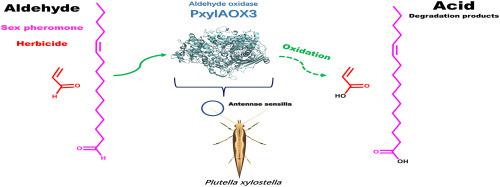当前位置:
X-MOL 学术
›
Pestic. Biochem. Phys.
›
论文详情
Our official English website, www.x-mol.net, welcomes your
feedback! (Note: you will need to create a separate account there.)
A candidate aldehyde oxidase in the antennae of the diamondback moth, Plutella xylostella (L.), is potentially involved in the degradation of pheromones, plant-derived volatiles and the detoxification of xenobiotics
Pesticide Biochemistry and Physiology ( IF 4.2 ) Pub Date : 2021-01-01 , DOI: 10.1016/j.pestbp.2020.104726 Mei-Mei Wang , Ming He , Hong Wang , Yun-Feng Ma , Youssef Dewer , Fan Zhang , Peng He
Pesticide Biochemistry and Physiology ( IF 4.2 ) Pub Date : 2021-01-01 , DOI: 10.1016/j.pestbp.2020.104726 Mei-Mei Wang , Ming He , Hong Wang , Yun-Feng Ma , Youssef Dewer , Fan Zhang , Peng He

|
Insect antennae play a fundamental role in perceiving and recognizing a broad spectrum of conventional semiochemicals and host plant-derived odors. As such, genes that are tightly associated with the antennae are thought to have olfactory-related roles related to signal transduction mechanisms. Several mechanisms suggest that enzymatic inactivation could contribute to the signal termination process, such as odorant-degrading enzymes (ODEs). To date, a few ODEs have been identified and characterized in detail in insect herbivores, but little is known about aldehyde oxidases (AOXs); moreover, direct in vivo experimental evidence is needed. AOXs are a major family of metabolic enzymes that oxidize a variety of aromatic aldehydes, and they may also play a significant role in detoxification and degradation of environmental chemical cues. Here, we report on the identification and characterization of a novel cDNA encoding the putative odorant-degrading enzyme, PxylAOX3, from the antennae of the diamondback moth, (DBM), Plutella xylostella (L.) (Lepidoptera: Plutellidae). The purified recombinant protein showed a wide-range of substrate zymography oxidizing both sex pheromone compounds as well as plant-derived aldehydes with distinct activities. Our data suggest PxylAOX3 might be involved in the degradation of many structurally diverse aldehyde odorants. Furthermore, PxylAOX3 could participate in olfactory neuron protection by inactivation of redundant odorants and xenobiotic detoxification, making it a potential target for pesticide development as well.
中文翻译:

小菜蛾触角中的候选醛氧化酶 Plutella xylostella (L.),可能参与信息素、植物源性挥发物的降解和外源性物质的解毒
昆虫触角在感知和识别广谱的常规信息素和宿主植物来源的气味方面发挥着重要作用。因此,与触角紧密相关的基因被认为具有与信号转导机制相关的嗅觉相关作用。几种机制表明酶失活可能有助于信号终止过程,例如气味降解酶 (ODE)。迄今为止,已经在昆虫食草动物中鉴定并详细表征了一些 ODE,但对醛氧化酶 (AOX) 知之甚少。此外,还需要直接的体内实验证据。AOXs 是一个主要的代谢酶家族,可氧化各种芳香醛,它们也可能在环境化学线索的解毒和降解中发挥重要作用。这里,我们报告了编码假定的气味降解酶 PxylAOX3 的新型 cDNA 的鉴定和表征,该酶来自小菜蛾 (DBM)、小菜蛾 (L.)(鳞翅目:小菜蛾科)的触角。纯化的重组蛋白显示出广泛的底物酶谱氧化性信息素化合物以及具有不同活性的植物来源的醛。我们的数据表明 PxylAOX3 可能参与了许多结构不同的醛类气味剂的降解。此外,PxylAOX3 可以通过灭活多余的气味和异物解毒来参与嗅觉神经元保护,使其成为农药开发的潜在目标。来自小菜蛾 (DBM)、Plutella xylostella (L.) (Lepidoptera: Plutellidae) 的触角。纯化的重组蛋白显示出广泛的底物酶谱氧化性信息素化合物以及具有不同活性的植物来源的醛。我们的数据表明 PxylAOX3 可能参与了许多结构不同的醛类气味剂的降解。此外,PxylAOX3 可以通过灭活多余的气味和异物解毒来参与嗅觉神经元保护,使其成为农药开发的潜在目标。来自小菜蛾 (DBM)、Plutella xylostella (L.) (Lepidoptera: Plutellidae) 的触角。纯化的重组蛋白显示出广泛的底物酶谱氧化性信息素化合物以及具有不同活性的植物来源的醛。我们的数据表明 PxylAOX3 可能参与了许多结构不同的醛类气味剂的降解。此外,PxylAOX3 可以通过灭活多余的气味和异物解毒来参与嗅觉神经元保护,使其成为农药开发的潜在目标。我们的数据表明 PxylAOX3 可能参与了许多结构不同的醛类气味剂的降解。此外,PxylAOX3 可以通过灭活多余的气味和异物解毒来参与嗅觉神经元保护,使其成为农药开发的潜在目标。我们的数据表明 PxylAOX3 可能参与了许多结构不同的醛类气味剂的降解。此外,PxylAOX3 可以通过灭活多余的气味和异物解毒来参与嗅觉神经元保护,使其成为农药开发的潜在目标。
更新日期:2021-01-01
中文翻译:

小菜蛾触角中的候选醛氧化酶 Plutella xylostella (L.),可能参与信息素、植物源性挥发物的降解和外源性物质的解毒
昆虫触角在感知和识别广谱的常规信息素和宿主植物来源的气味方面发挥着重要作用。因此,与触角紧密相关的基因被认为具有与信号转导机制相关的嗅觉相关作用。几种机制表明酶失活可能有助于信号终止过程,例如气味降解酶 (ODE)。迄今为止,已经在昆虫食草动物中鉴定并详细表征了一些 ODE,但对醛氧化酶 (AOX) 知之甚少。此外,还需要直接的体内实验证据。AOXs 是一个主要的代谢酶家族,可氧化各种芳香醛,它们也可能在环境化学线索的解毒和降解中发挥重要作用。这里,我们报告了编码假定的气味降解酶 PxylAOX3 的新型 cDNA 的鉴定和表征,该酶来自小菜蛾 (DBM)、小菜蛾 (L.)(鳞翅目:小菜蛾科)的触角。纯化的重组蛋白显示出广泛的底物酶谱氧化性信息素化合物以及具有不同活性的植物来源的醛。我们的数据表明 PxylAOX3 可能参与了许多结构不同的醛类气味剂的降解。此外,PxylAOX3 可以通过灭活多余的气味和异物解毒来参与嗅觉神经元保护,使其成为农药开发的潜在目标。来自小菜蛾 (DBM)、Plutella xylostella (L.) (Lepidoptera: Plutellidae) 的触角。纯化的重组蛋白显示出广泛的底物酶谱氧化性信息素化合物以及具有不同活性的植物来源的醛。我们的数据表明 PxylAOX3 可能参与了许多结构不同的醛类气味剂的降解。此外,PxylAOX3 可以通过灭活多余的气味和异物解毒来参与嗅觉神经元保护,使其成为农药开发的潜在目标。来自小菜蛾 (DBM)、Plutella xylostella (L.) (Lepidoptera: Plutellidae) 的触角。纯化的重组蛋白显示出广泛的底物酶谱氧化性信息素化合物以及具有不同活性的植物来源的醛。我们的数据表明 PxylAOX3 可能参与了许多结构不同的醛类气味剂的降解。此外,PxylAOX3 可以通过灭活多余的气味和异物解毒来参与嗅觉神经元保护,使其成为农药开发的潜在目标。我们的数据表明 PxylAOX3 可能参与了许多结构不同的醛类气味剂的降解。此外,PxylAOX3 可以通过灭活多余的气味和异物解毒来参与嗅觉神经元保护,使其成为农药开发的潜在目标。我们的数据表明 PxylAOX3 可能参与了许多结构不同的醛类气味剂的降解。此外,PxylAOX3 可以通过灭活多余的气味和异物解毒来参与嗅觉神经元保护,使其成为农药开发的潜在目标。









































 京公网安备 11010802027423号
京公网安备 11010802027423号